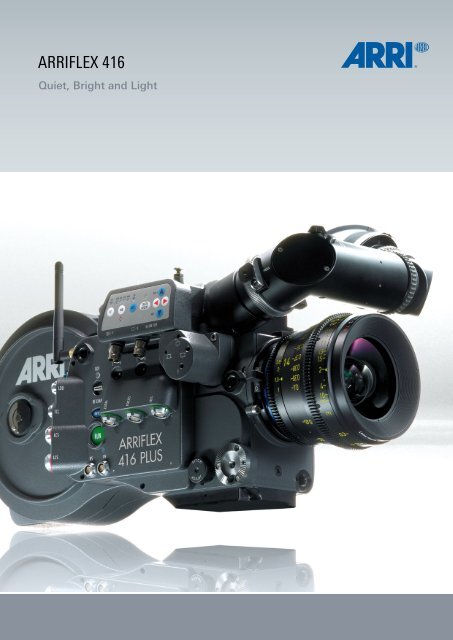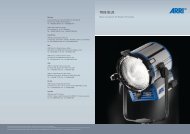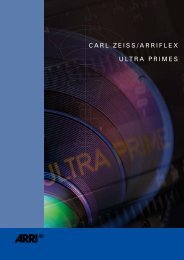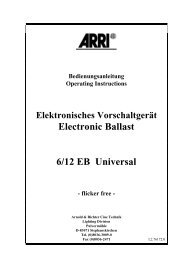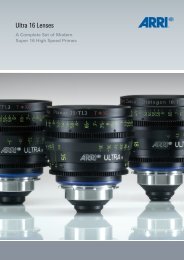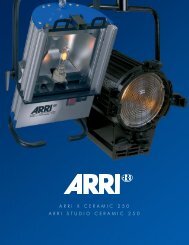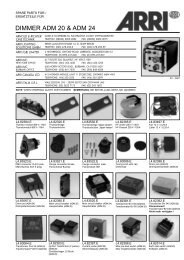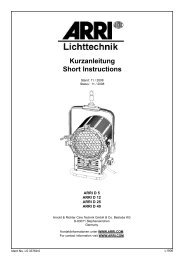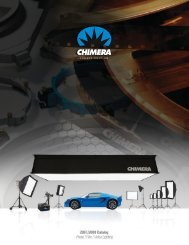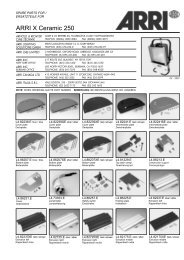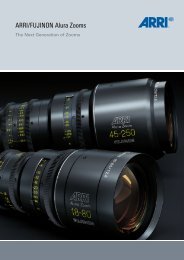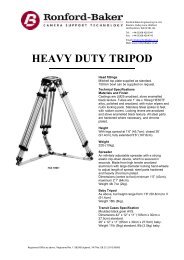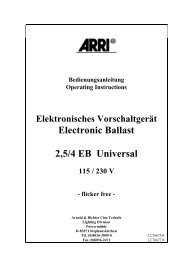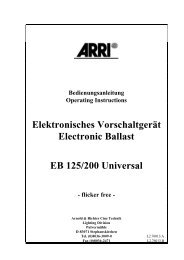ARRIFLEX 416 - Arri CSC
ARRIFLEX 416 - Arri CSC
ARRIFLEX 416 - Arri CSC
Create successful ePaper yourself
Turn your PDF publications into a flip-book with our unique Google optimized e-Paper software.
<strong>ARRIFLEX</strong> <strong>416</strong><br />
Quiet, Bright and Light
35 Format Features in a Super 16 Camera<br />
Continuous advances in lenses, film stock and postproduction<br />
technologies have elevated the Super 16 film format to new levels of<br />
image quality and production efficiency. Super 16 is now routinely<br />
used for standard and high definition television productions, feature<br />
films, commercials and documentaries, and with stunning results.<br />
By shooting Super 16, productions gain many of the advantages<br />
of shooting film - the film look, its unsurpassed exposure latitude,<br />
natural color reproduction, variable camera speeds, ramps, proven<br />
archivability and the fact that film is the only globally accepted<br />
standard format - at affordable production costs. The small size and<br />
light weight of Super 16 equipment has the extra benefit of easy<br />
portability for fast-paced production environments.<br />
In response to market demand, ARRI is offering three new Super<br />
16 cameras: the <strong>ARRIFLEX</strong> <strong>416</strong>, <strong>416</strong> Plus and <strong>416</strong> Plus HS. Based on<br />
years of camera engineering, market research and focus groups with<br />
renowned industry professionals, the <strong>ARRIFLEX</strong> <strong>416</strong> cameras make<br />
features previously only found in high end 35 mm cameras available<br />
to Super 16 productions.<br />
n Three Models<br />
· <strong>ARRIFLEX</strong> <strong>416</strong><br />
basic model<br />
· <strong>ARRIFLEX</strong> <strong>416</strong> Plus<br />
built-in accessory electronics and radio<br />
for wireless remote control<br />
· <strong>ARRIFLEX</strong> <strong>416</strong> Plus HS<br />
high speed for slow-motion effects with<br />
built-in accessory electronics and radio<br />
All three <strong>ARRIFLEX</strong> <strong>416</strong>s are lightweight, modern Super 16 film<br />
cameras, each with a 35-style viewfinder and a mirror shutter that can<br />
be manually adjusted from 45 to 180 degrees. The <strong>416</strong> and <strong>416</strong> Plus<br />
have an amazingly low sound level similar to that of the ARRICAM.<br />
Their speed range is from 1 to 75 fps, while the <strong>416</strong> Plus HS runs<br />
from 1 to 150 fps. A completely new lightweight ergonomic design,<br />
integrated electronic accessories in the Plus cameras and compatibility<br />
with the same lenses and accessories used by their 35 mm siblings<br />
make the <strong>416</strong> cameras the most powerful, flexible and portable Super<br />
16 cameras ever built.<br />
2
ARRI | <strong>ARRIFLEX</strong> <strong>416</strong><br />
Main Features<br />
n Compact & Lightweight<br />
· small camera body<br />
· low profile design<br />
· 25% lighter than 16SR 3<br />
n The Quietest 16 mm Camera<br />
· <strong>416</strong> & <strong>416</strong> Plus:<br />
sound less than 20 db(A)<br />
n High Quality Video Assist<br />
· improved image quality<br />
· adjustable image enhancement<br />
n 35-style Viewfinder<br />
· brighter, higher contrast, higher resolution<br />
· bigger exit pupil allows more eye movement<br />
· multi-color RGB ARRIGLOW<br />
· accommodates even wide diameter PL mount lenses<br />
· excellent optical quality with eyepiece extension<br />
n Ergonomic Design<br />
· ergonomic shoulder cut out<br />
· viewfinder removes quickly for Steadicam and remote applications<br />
· optional integrated radio & lens motor drivers<br />
· split bridgeplate for fast switch from tripod to shoulder<br />
3
I Can See Clearly Now<br />
To capture the images you want, you have first to see them clearly.<br />
So viewfinder quality is crucial if an operator is to accurately appraise<br />
images, especially with 16 mm. The optical viewfinder on the<br />
<strong>416</strong> cameras makes it easy to judge focus, create a precise image<br />
composition, and work comfortably and efficiently.<br />
The viewfinder optics have been redesigned from the ground up,<br />
incorporating fewer lens elements of higher quality and a shorter<br />
optical path. The results are significantly higher contrast, higher<br />
resolution and a brighter image. With the <strong>416</strong> cameras, judging<br />
focus on the set becomes a lot easier, and unpleasant surprises<br />
during dailies a lot less likely.<br />
The <strong>416</strong> cameras' viewfinder ergonomics are based on the<br />
<strong>ARRIFLEX</strong> 235 viewfinder so they share the same freedom of<br />
movement and features. The <strong>416</strong> viewfinder can be freely rotated,<br />
extended or flipped to the other camera side for comfortable<br />
viewing in any camera position. Image orientation can be set<br />
automatically or manually and medium or long eyepiece extensions<br />
can be used with no loss in image quality. Since the <strong>416</strong> cameras'<br />
viewfinder has a large exit pupil, the operator has more freedom<br />
to move without losing the image - a great advantage when going<br />
hand held, shooting action sequences or executing complex dolly<br />
moves. In contrast to their predecessors, the <strong>416</strong> cameras accept<br />
large diameter 35 format primes, including the new Master Primes,<br />
because their viewfinder is located higher above the lens mount.<br />
4
ARRI | <strong>ARRIFLEX</strong> <strong>416</strong><br />
The <strong>ARRIFLEX</strong> <strong>416</strong> cameras' optical viewfinder<br />
uses a completely new optical design,<br />
resulting in significantly higher contrast,<br />
higher resolution and a brighter image.<br />
5
z light path inside camera body<br />
z light path inside viewfinder<br />
AN<br />
AM<br />
AL<br />
AO<br />
AK<br />
AT<br />
AP<br />
AQ<br />
9<br />
u Mirror Shutter<br />
A half-moon shaped mirror rotates<br />
in front of the film gate at the<br />
camera speed. Half of the time the<br />
mirror covers the film and the light<br />
from the taking lens is reflected<br />
up into the viewfinder. During that<br />
time, the film is transported one<br />
frame further. The other half of<br />
the time the mirror leaves the light<br />
path open, so the light from the<br />
taking lens is projected onto the<br />
film, exposing an image. Since the<br />
mirror's function is to both reflect<br />
and shutter light, it is known as a<br />
"mirror shutter".<br />
v Fiber Optic Screen<br />
The light from the lens is projected<br />
onto a screen (a fiber optic screen<br />
in the <strong>416</strong> cameras), which acts<br />
as a rear projection screen. This is<br />
where the viewfinder image forms.<br />
w Field Lens<br />
The field lens (named as such<br />
because located close to the<br />
image field) refracts the light into<br />
the entrance pupil of the primary<br />
viewfinder lens and the video assist<br />
lens.<br />
x Video Assist Beam Splitter<br />
80% of the light passes straight up,<br />
while 20% is reflected to the side<br />
and projected through the video<br />
assist optics (not pictured) onto the<br />
video assist CCD sensor.<br />
y Supplementary Lens<br />
U Protective Glass<br />
An optically clear glass plate on the<br />
top surface of the camera body protects<br />
the components underneath<br />
from dirt contamination.<br />
V Supplementary Lens<br />
W ARRIGLOW LED Module<br />
Red green and blue LEDs are situated<br />
on an electronics board above<br />
the partial mirror.<br />
X Partial Mirror<br />
The light from the fiber optic screen<br />
is reflected into the viewfinder.<br />
At the same time, the light from<br />
the ARRIGLOW LEDs above is let<br />
through. This light is then reflected<br />
off the frame line markings on the<br />
fiber optic screen, providing illuminated<br />
frame lines when needed.<br />
at 90 Degree Prism<br />
ak Primary Lens<br />
Picks up the image from the fiber<br />
optic screen.<br />
al Mirror<br />
am Pechan Prism<br />
Automatically keeps the image<br />
upright when the viewfinder is<br />
rotated. Also allows for manual<br />
image rotation.<br />
an Secondary Lens<br />
Provides the image for the eyepiece.<br />
ao Mirror<br />
ap Protective Glass<br />
Located at the mechanical interface<br />
to the eyepiece or eyepiece<br />
extension, this protective glass<br />
prevents dust from getting into the<br />
viewfinder optics.<br />
aq Eyepiece<br />
The eyepiece allows the operator to<br />
view the image. It also provides a<br />
focus adjustment of approximately<br />
+/- 3 diopters.<br />
6
ARRI | <strong>ARRIFLEX</strong> <strong>416</strong><br />
Advantages of Optical Viewfinders<br />
Optical viewfinders, as used in all ARRI cameras, provide by far the most<br />
comfortable, accurate and efficient way to work when capturing images.<br />
Operators see a bright and sharp, full color image and are able to accurately<br />
judge focus. By their very nature, optical viewfinders have zero delay, showing<br />
exactly what is happening, right when it is happening.<br />
Optical viewfinders show an area larger than the image recorded on film,<br />
ensuring that microphones, light stands and other debris do not make an appearance<br />
in frame, thus minimizing the need for re-takes and saving precious<br />
time on the set. Operators also find this extra area around the image crucial<br />
for precise composition and exacting camera movements.<br />
COMFORTABLE,<br />
ACCURATE & EFFICIENT<br />
In addition, optical viewfinders work without power, are less fatiguing<br />
to the eye than electronic viewfinders and can be equipped with a range of<br />
accessories such as medium and long eyepiece extensions, eyepiece levelers<br />
and heated eyecups. A large exit pupil ensures that the operator has more<br />
freedom to move without losing the image.<br />
How Does an Optical Viewfinder Work?<br />
An optical viewfinder is essentially a small rear projection screen and a magnifying<br />
glass. The taking lens projects light onto a screen; for 16 mm cameras<br />
this is usually a fiber optic screen, while for 35 mm cameras it is usually a<br />
ground glass. An image is formed on the screen. The screen has a specifically<br />
chosen granularity that allows the operator to precisely judge focus and depth<br />
of field.<br />
The rest of the viewfinder is a very sophisticated magnification apparatus<br />
that allows the operator to view this image properly. Since the image on<br />
the screen will be magnified about 8 times by the viewing system before it<br />
reaches the human eye, high quality viewfinder optics and precision assembly<br />
are crucial. Through the use of mirrors and prisms the viewfinder can be<br />
re-oriented freely in space, allowing the operator to see an upright image<br />
irrespective of how the viewfinder is positioned.<br />
A small part of the light in the viewfinder is split off and directed to a CCD<br />
sensor, which creates a video image - the so called "video assist" - allowing<br />
others besides the operator to see the image.<br />
The specific light path pictured here is from the <strong>ARRIFLEX</strong> <strong>416</strong> cameras,<br />
but it is similar in principle to that of all optical viewfinders.<br />
7
RGB ARRIGLOW<br />
With the new RGB ARRIGLOW, you can choose any color you like. Set evenly<br />
illuminated framelines in magenta when shooting green screen, red for jungle<br />
or yellow for blue skies. You can, of course, also mix your own ARRIGLOW<br />
grey.<br />
Integrated Video Assist<br />
The <strong>416</strong> cameras' viewfinder is accompanied by a video assist with the same<br />
features and image quality as the highly praised ARRICAM and 435 integrated<br />
video assists (IVS). This video assist is closely integrated into the camera body<br />
to keep the overall camera size small and slim. It also features some added<br />
benefits like color bars, adjustable electronic image enhancement, manual<br />
white balance and a ground fault warning.<br />
MIX YOUR<br />
OWN COLOR<br />
Using the same optical layout already proven in the <strong>ARRIFLEX</strong> 235, viewfinder<br />
and video assist are independent of each other. This makes a switch<br />
from handheld to Steadicam very fast and eliminates the need for a 100% video<br />
top. Additionally, two 12V accessory outputs on the video assist can power an<br />
on-board monitor and a video transmitter at the same time.<br />
High quality video assist<br />
8
ARRI | <strong>ARRIFLEX</strong> <strong>416</strong><br />
HDTV 1.78 HDTV 1.78<br />
Old 16 mm Camera Viewfinder Image<br />
<strong>ARRIFLEX</strong> <strong>416</strong> Viewfinder Image<br />
n Higher contrast, higher resolution, brighter image<br />
n Easier to judge focus on the set<br />
n Excellent optical quality with eyepiece extension<br />
Mix Your Own RGB ARRIGLOW Color<br />
n Use magenta for green screen<br />
n Red for jungle<br />
n Yellow for blue skies<br />
n Mix your own grey<br />
HDTV 1.78 HDTV 1.78 HDTV 1.78 HDTV 1.78<br />
9
The Sound of Silence<br />
The <strong>416</strong> cameras use a completely new sound insulation design that makes the <strong>416</strong><br />
and <strong>416</strong> Plus as quiet as an ARRICAM and allows the <strong>416</strong> Plus HS to record a very<br />
stable image even at higher frame rates. An inner skeleton is suspended by symmetrically<br />
positioned rubber insulators in an outer shell. The camera's movement and<br />
other parts that create vibrations - and thus unwanted sound - are mounted to the<br />
inner skeleton. The insulators prevent any sound from the inner skeleton radiating to<br />
the outer shell. The symmetrical positioning of the insulators ensures that the flange<br />
focal distance stays constant so there is no change in depth from heat or cold.<br />
The <strong>416</strong> magazine is powered by a brushless silent torque motor; there is no<br />
noisy mechanical linkage between camera and magazine. And just like the camera,<br />
the <strong>416</strong> magazine consists of an inner skeleton and an outer shell separated by<br />
rubber insulators, making it the quietest 16 mm magazine ever built.<br />
When working with a truly silent sync sound camera, directors and actors can<br />
concentrate on the performance and crews can concentrate on the action. How<br />
much time has been wasted on sets dealing with camera sound problems? With a<br />
sound level of less than 20 db(A), the <strong>ARRIFLEX</strong> <strong>416</strong> and <strong>416</strong> Plus are so silent that<br />
sound recordists will be asking the same question they ask when working with the<br />
ARRICAM: is the camera really running?<br />
IS THE CAMERA<br />
REALLY RUNNING?<br />
The camera body's inner skeleton is held by rubber<br />
insulators to prevent sound from radiating.<br />
SUPER SILENT < 20db(A)<br />
10
ARRI | <strong>ARRIFLEX</strong> <strong>416</strong><br />
4<br />
5<br />
6<br />
1<br />
2<br />
u body outer shell<br />
v body inner skeleton<br />
w body rubber insulators<br />
x magazine outer shell<br />
y magazine inner skeleton<br />
U magazine rubber insulators<br />
6<br />
The magazine is driven by an internal silent motor and<br />
uses the same insulating technique as the camera body,<br />
ensuring completely quiet operation.<br />
11
QUIET<br />
BRIGHT &<br />
LIGHT
<strong>ARRIFLEX</strong> <strong>416</strong> Models<br />
<strong>ARRIFLEX</strong> <strong>416</strong><br />
Super silent and equipped with<br />
basic electronics<br />
<strong>ARRIFLEX</strong> <strong>416</strong> Plus<br />
Super silent & flexible with built-in accessory electronics<br />
and radio for wireless remote control<br />
<strong>ARRIFLEX</strong> <strong>416</strong> Plus HS<br />
Super fast for slow-motion effects with<br />
built-in accessory electronics and radio<br />
for wireless remote control<br />
Speed Range (fps) 1 - 75 1 - 75 1 - 150<br />
Sound (dbA) < 20 < 20 < 29<br />
Weight (Kg/Lbs) [1] 5.5/12.1 5.8/12.8 5.8/12.8<br />
Integrated Accessory<br />
Electronics<br />
no yes yes<br />
[1] Body, viewfinder, loaded magazine, video assist<br />
14
ARRI | <strong>ARRIFLEX</strong> <strong>416</strong><br />
25% LIGHTER<br />
THAN SR 3<br />
Compact, Lightweight and Fast<br />
One of the reasons cinematographers and producers with demanding schedules<br />
choose to shoot Super 16 is the faster production pace afforded by smaller and<br />
lighter equipment. A Super 16 camera fits into any location, can be mounted<br />
to almost anything and can be quickly used on the shoulder. The <strong>416</strong> cameras<br />
further increase this portability, while providing many of the features crews have<br />
come to expect of 35 mm cameras.<br />
The <strong>416</strong> weight has been reduced by an amazing 25% in comparison to the<br />
16SR 3, when comparing a configuration including body, viewfinder, IVS and<br />
magazine. When comparing the <strong>416</strong> Plus to a 16SR 3 with UMC-3, the difference<br />
is even greater. The <strong>416</strong> cameras' shape has been designed to make them as<br />
compact as possible and to give them a low profile. At the same time shape and<br />
weight are perfectly balanced for comfortable shoulder operation.<br />
A lot of thought has been put into the ergonomics of having to work quickly<br />
and safely on a film set. The new magazine, as well as the new on-board battery,<br />
can be swiftly removed with one hand. The cameras new front shape makes<br />
attaching lens accessories easier and faster.<br />
For slow-motion sequences the <strong>416</strong> Plus HS runs up to 150 fps, while still<br />
using the same magazines as the <strong>416</strong> and <strong>416</strong> Plus. To avoid the clutter of extra<br />
boxes and cables, the <strong>416</strong> Plus and <strong>416</strong> Plus HS have lens motor electronics and<br />
a wireless radio directly integrated into the camera body.<br />
Last but not least, there is the new split bridgeplate. The cameras can be<br />
removed from a zoom lens/tripod configuration in two quick steps: open the lens<br />
mount, split the bridgeplate and the camera slides off. The second assistant can<br />
then dismantle the zoom lens while the operator is already shooting handheld.<br />
<strong>416</strong> Built-In Accessory Electronics<br />
n<br />
n<br />
n<br />
Reduce clutter through<br />
accessory electronics<br />
integrated into camera body<br />
Lens motors plug directly<br />
into camera<br />
Wireless remote control<br />
without extra boxes<br />
<strong>416</strong> Split Bridgeplate<br />
n Elevates <strong>416</strong> to proper height for accessories<br />
n Fast switch from tripod to shoulder<br />
15
PL Mount and Lenses<br />
The <strong>416</strong> cameras use the industry standard 54 mm stainless steel PL mount. The<br />
stable backfocus afforded by the PL mount and by the robust camera construction<br />
is a hallmark of all ARRI film cameras.<br />
The PL mount makes the vast selection of high quality lenses for the Super<br />
16 and 35 mm formats available to the <strong>ARRIFLEX</strong> <strong>416</strong> cameras. This includes the<br />
Master Primes, which combine the highest optical quality with a super fast stop of<br />
T1.3, as well as the Ultra Primes, the modern prime lens set with the widest focal<br />
range from 8 to 180 mm. It also includes all the specialty lenses available only for<br />
film cameras, such as macro lenses, super long telephoto zooms or zooms with a<br />
super wide range, fisheyes, extreme telephotos, shift & tilt lenses, tilt focus lenses,<br />
reverse perspective lenses, squishy lenses and so on.<br />
A complete set of new T1.3 prime lenses has been developed specifically for<br />
the Super 16 format: the Ultra 16 lenses. With focal lengths of 6, 8, 9.5, 12, 14, 18,<br />
25, 35 and 50 mm, the Ultra 16 lenses cover the whole range typically required by<br />
a production. They are a perfect match for the <strong>416</strong> cameras, exhibiting the same<br />
resistance to flare as the Master Primes and giving unprecedented image quality<br />
even when opened to their maximum aperture of T1.3. Their high speed creates<br />
shallow depth of field and allows shooting on tight lighting budgets or under<br />
severe time pressure.<br />
THE NEW<br />
ULTRA 16 LENSES<br />
The <strong>416</strong> uses the industry standard PL mount.<br />
This affords stable backfocus and an unparalleled selection of lenses.<br />
16
ARRI | <strong>ARRIFLEX</strong> <strong>416</strong><br />
The Ultra 16 lenses: 6, 8, 9.5, 12, 14, 18, 25, 35 and 50 mm, all T1.3<br />
The Ultra Primes: T2.8/8, T2.1/10, T2/12, T1.9/14, T1.9/16, T1.9/20, T1.9/24, T1.9/28, T1.9/32, T1.9/40, T1.9/50, T1.9/65, T1.9/85, T1.9/100, T1.9/135 and T1.9/180 mm<br />
17
Control and Power<br />
The simple to use control panel on the <strong>416</strong> range should be familiar to<br />
anyone who has ever worked with a modern ARRI camera, since the <strong>416</strong><br />
cameras have inherited the 235's control panel design and illuminated<br />
buttons. All three <strong>416</strong> cameras can therefore be operated without further<br />
training and the setting of any operating parameter can be accomplished<br />
quickly and intuitively.<br />
The powerful and smart Lithium-ion OBB-2 on-board battery can run<br />
up to five magazines while keeping camera and video assist in standby for<br />
more than two hours. With a built-in power gauge the state of an OBB-2<br />
can quickly be determined, and since the OBB-2 communicates with the<br />
camera, the <strong>416</strong> cameras can accurately display the battery's current<br />
voltage, remaining capacity or how many more magazines the battery's<br />
charge will run. A quick change mechanism, which can be easily operated<br />
with one hand, is integrated into the cameras' bodies and reduces overall<br />
weight.<br />
The same familiar controls found on the 235, 435 and 535 have also been used for the <strong>416</strong>.<br />
18
ARRI | <strong>ARRIFLEX</strong> <strong>416</strong><br />
The OBB-2 connects to the <strong>416</strong> cameras through a new,<br />
but backwards-compatible power connector.<br />
19
ARRI | <strong>ARRIFLEX</strong> <strong>416</strong><br />
MODULAR<br />
SYSTEM<br />
The <strong>416</strong> Camera System<br />
The <strong>ARRIFLEX</strong> <strong>416</strong> cameras are complemented by a range of new and existing<br />
accessories that follow the same design philosophy used in the creation of the<br />
<strong>416</strong> body and magazines: increasing efficiency on the set.<br />
Two handles have been designed: one for normal use, one for remote. These<br />
include such details as a flip-up tape hook and different height platforms for<br />
Steadicam and for under-slinging the camera on a remote head. Lens motors<br />
or lightweight follow focus units can be mounted on the camera left side with<br />
the help of the Left Rod Bracket LRB-2. Like the 235, the <strong>416</strong> cameras have<br />
extra 3/8" attachment points with locating pin holes for twist-free attachment of<br />
accessories or extra secure rigging.<br />
The <strong>416</strong> cameras are compatible with most of the accessories used by<br />
their 35 mm siblings, including the ARRI Remote Control Unit RCU-1, External<br />
Display EXD-1, Wireless Remote System, Wireless Remote Control WRC-1 &<br />
WRC-2, Universal Motor Controller UMC-3, Iris Control Unit ICU, Electronic<br />
Synchronization Unit ESU, most follow focus units and matte boxes. They<br />
have also inspired some new accessories, including the Heated Eyecup HE-5,<br />
which automatically closes its iris when the operator is not looking through the<br />
viewfinder.<br />
21
Technical Data<br />
<strong>ARRIFLEX</strong> <strong>416</strong> <strong>ARRIFLEX</strong> <strong>416</strong> Plus <strong>ARRIFLEX</strong> <strong>416</strong> Plus HS<br />
Fps 1-75 1-150<br />
Speed can be varied while camera runs<br />
Ramps possible with Remote Control Unit RCU-1, Wireless Remote Control WRC-1, WRC-2 and Iris Control Unit ICU-1<br />
Shutter<br />
Manually adjustable to: 45, 90, 135, 144, 150, 172.8, 180 degrees<br />
Film Format<br />
Super 16 mm, conforming to DIN 15602 and ISO-5768-1998<br />
Film Gate<br />
Super 16 only (12.35 x 7.5 mm, 0.486 x 0.295 inches)<br />
Lens Mount<br />
54 mm stainless steel PL mount<br />
Sound < 20 db(A) @ 24 fps
ARRI | <strong>ARRIFLEX</strong> <strong>416</strong><br />
23
Germany<br />
Arnold & Richter Cine Technik (Headquarters, Sales & Service)<br />
Türkenstraße 89, D-80799 Munich, Germany<br />
Tel: +49 (0)89 3809 0, Fax: +49 (0)89 3809 1245<br />
Great Britain<br />
ARRI GB Limited (Sales & Service)<br />
2 Highbridge, Oxford Road, Uxbridge, Middlesex, UB8 1LX, Great Britain<br />
Imaging Equipment Sales: Allan Fyfe, afyfe@arri-gb.com<br />
Tel: +44 (0)1895 457 000, Fax: +44 (0)1895 457 001<br />
Italy<br />
ARRI Italia S.r.l. (Sales & Service, Milan)<br />
Viale Edison 318, 20099 Sesto San Giovanni (Milano), Italy<br />
General Manager: Antonio Cazzaniga, acazzaniga@arri.it<br />
Tel: +39 (02)262 271 75, Fax: +39 (02)242 1692<br />
ARRI Italia S.r.l. (Sales & Service, Rome)<br />
Via Placanica 97, 00040 Morena (Roma), Italy<br />
Camera Sales: Mauro Sembroni, msembroni@arri.it<br />
Tel: +39 (06)79 89 021, Fax: +39 (06)79 89 02 206<br />
USA<br />
ARRI Inc. (Sales & Service, East Coast)<br />
617 Route 303, Blauvelt, NY 10913-1109, USA<br />
Vice President: Jürgen Schwinzer, jschwinzer@arri.com<br />
Tel: +1 (845)353 1400, Fax: +1 (845)425 1250<br />
ARRI Inc. (Sales & Service, West Coast)<br />
600 North Victory Blvd., Burbank, CA 91502-1639, USA<br />
Vice President: Bill Russell, brussell@arri.com<br />
Tel: +1 (818)841 7070, Fax: +1 (818)848 4028<br />
Canada<br />
ARRI Canada Limited (Sales & Service)<br />
415 Horner Ave. Unit 11 & 12, Toronto, Ontario M8W 4W3, Canada<br />
Accounts Manager, Camera & Digital Systems:<br />
Sébastien Laffoux, seb@arrican.com<br />
Tel: +1 (<strong>416</strong>)255 3335, Fax: +1 (<strong>416</strong>)255 3399<br />
Asia<br />
ARRI Asia Limited<br />
Office 3B on 29/F, The Centrium, 60 Wyndham Street, Central, Hong Kong<br />
General Manager: Paul Ivan, pivan@arri.com<br />
Tel: +852 9018 2066, Fax: +852 3755 6371<br />
Australia<br />
ARRI Australia PTY Limited<br />
Unit 6C, 5 Talavera Road, Macquarie Park NSW 2113, Sydney, Australia<br />
General Manager: Stefan Sedlmeier, ssedlmeier@arri.com.au<br />
Tel: +61 (2)9855 4308, Fax: +61 (2)9855 4301<br />
This <strong>ARRIFLEX</strong> <strong>416</strong> product brochure (K5.40459.0) is published by Arnold & Richter Cine Technik, April 01, 2008 © ARRI/2008<br />
Technical data and offerings are subject to change without notice. All rights reserved. Without any warranty. Not binding 04/2008. ARRI is a registered trademark of Arnold & Richter Cine Technik GmbH & Co. Betriebs KG.<br />
Arnold & Richter Cine Technik GmbH & Co. Betriebs KG · Türkenstrasse 89 · D-80799 Munich · phone +49 (0)89 3809 0 · fax +49 (0)89 3809 1245 · www.arri.com


